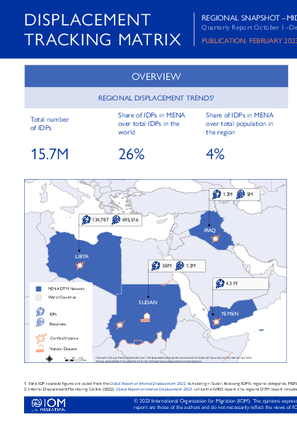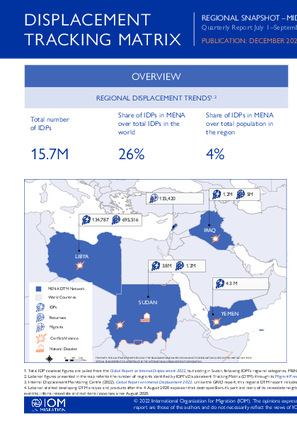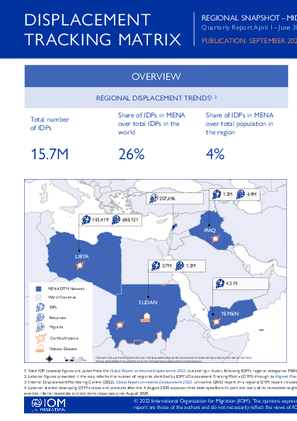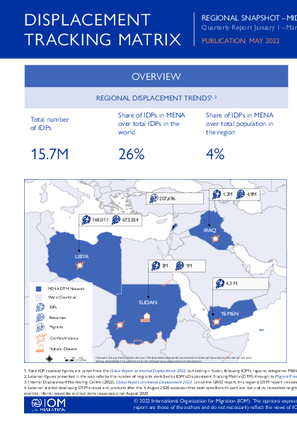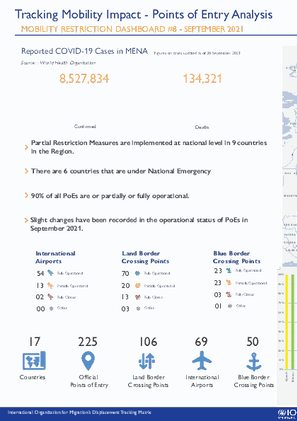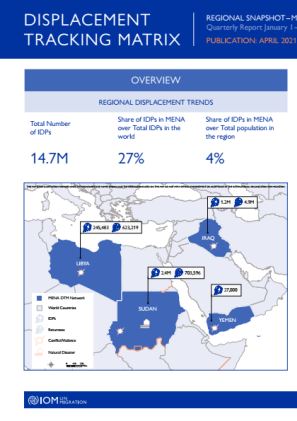-
Countries
-
Data and Analysis
-
Special Focus
-
Crisis Responses
Monthly Regional Update (Middle East and North Africa)
Title Standard
Middle East and North Africa — Monthly Regional Update (April 2018)
Contact
DTM Support, DTMSupport@iom.int
Type
Component
Confidential
Region
The Displacement Tracking Matrix (DTM) provides primary data and information on internal displacement and population movements – incountry and at regional and global levels. DTM’s work worldwide informs humanitarian, recovery, transition and development interventions by providing timely data and analysis to relevant actors including governments, United Nations partner agencies, donors and other stakeholders. DTM operates in contexts where conflict, natural disasters and complex emergency settings can cause short-term or protracted displacement, as well as in mixed migration contexts. In the Middle East and North Africa (MENA) region, there were 15.7 million internally displaced persons (IDPs) in 2021. This figure constitutes 26 per cent of the global population of IDPs, making MENA the region with the second highest concentration of IDPs worldwide (following the sub-Saharan Africa region). Most displacement in the MENA region (81%) has been triggered by armed conflict, in particular in Iraq, Libya, Syria and Yemen.
The Displacement Tracking Matrix (DTM) provides primary data and information on internal displacement and population movements – incountry and at regional and global levels. DTM’s work worldwide informs humanitarian, recovery, transition and development interventions by providing timely data and analysis to relevant actors including governments, United Nations partner agencies, donors and other stakeholders. DTM operates in contexts where conflict, natural disasters and complex emergency settings can cause short-term or protracted displacement, as well as in mixed migration contexts. In the Middle East and North Africa (MENA) region, there were 15.7 million internally displaced persons (IDPs) in 2021. This figure constitutes 26 per cent of the global population of IDPs, making MENA the region with the second highest concentration of IDPs worldwide (following the sub-Saharan Africa region). Most displacement in the MENA region (81%) has been triggered by armed conflict, in particular in Iraq, Libya, Syria and Yemen.
The Displacement Tracking Matrix (DTM) provides primary data and information on internal displacement and population movements – incountry and at regional and global levels. DTM’s work worldwide informs humanitarian, recovery, transition and development interventions by providing timely data and analysis to relevant actors including governments, United Nations partner agencies, donors and other stakeholders. DTM operates in contexts where conflict, natural disasters and complex emergency settings can cause short-term or protracted displacement, as well as in mixed migration contexts. In the Middle East and North Africa (MENA) region, there were 15.7 million internally displaced persons (IDPs) in 2021. This figure constitutes 26 per cent of the global population of IDPs, making MENA the region with the second highest concentration of IDPs worldwide (following the sub-Saharan Africa region). Most displacement in the MENA region (81%) has been triggered by armed conflict, in particular in Iraq, Libya, Syria and Yemen.
The Displacement Tracking Matrix (DTM) provides primary data and information on internal displacement and population movements – incountry and at regional and global levels. DTM’s work worldwide informs humanitarian, recovery, transition and development interventions by providing timely data and analysis to relevant actors including governments, United Nations partner agencies, donors and other stakeholders. DTM operates in contexts where conflict, natural disasters and complex emergency settings can cause short-term or protracted displacement, as well as in mixed migration contexts.
In the Middle East and North Africa (MENA) region, there were 15.7 million internally displaced persons (IDPs) in 2021.3 This figure constitutes 26 per cent of the global number of IDPs, making the MENA the region with the second highest concentration of IDPs following the sub-Saharan Africa region. Most displacement in the MENA region (81%) has been triggered by armed conflict, in particular in Iraq, Libya, Syria and Yemen.
This Middle East and North Africa (MENA) report summarizes mobility restrictions at airports, land, and blue border crossing points resulting from the mitigation measures implemented in response to the COVID-19 pandemic.
The DTM Regional snapshot contains consolidated summary updates and highlights from DTM field operations. This document covers updates from the regional network of flow monitoring of migrants and the tracking and monitoring of internal displacement in the countries. It is published every quarter and covers the Middle East and North Africa Region.
The DTM Regional snapshot contains consolidated summary updates and highlights from DTM field operations. This document covers updates from the regional network of flow monitoring of migrants and the tracking and monitoring of internal displacement in the countries. It is published every quarter and covers the Middle East and North Africa Region.
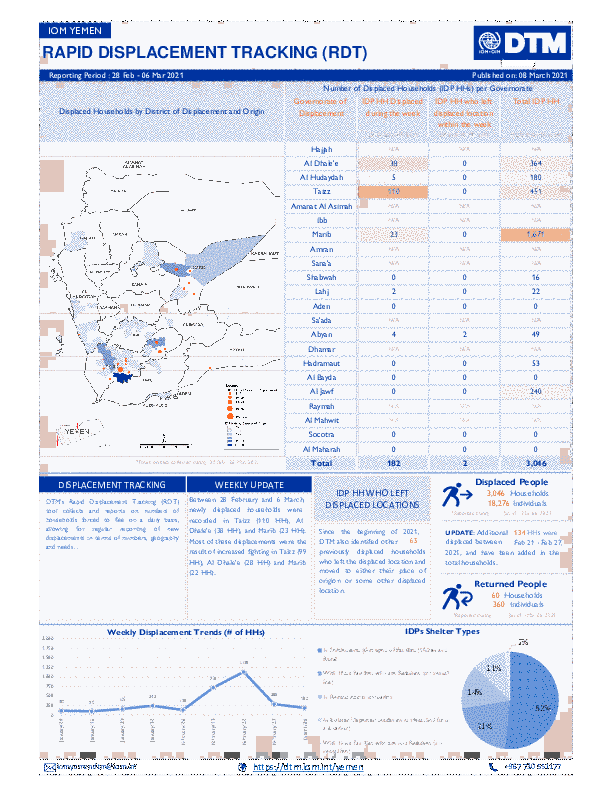
Contact
DTM Yemen, iomyemendtm@iom.int
Language
English
Location
Yemen
Period Covered
Feb 28 2021
Mar 06 2021
Activity
- Rapid Emergency Registration
- Mobility Tracking
DTM’s Rapid Displacement Tracking (RDT) tool collects and reports on numbers of households forced to flee on a daily basis, allowing for regular reporting of new displacements in terms of numbers, geography, and needs.
From 01 January 2021 to 6 March 2021, IOM Yemen DTM estimates that 3,046 households (HH) (18,276 Individuals) have experienced displacement at least once.
Since the beginning of 2021, DTM also identified other 65 previously displaced households who left the displaced location and moved to either their place of origin or some other displaced location.
Between 01 February 2021 and 06 March 2021, IOM Yemen DTM tracked 182 households (1,092 individuals) displaced at least once. The highest number of displacements were seen in:
- Taizz (110 HH) – Al Ma'afer (69 HH), Jabal Habashy (8 HH), Al Misrakh (7 HH) districts. Most displacements in the governorate were internal.
- Al Dhale'e (38 HH) – Qa'atabah (21 HH), Ad Dhale'e (12 HH), Al Hussein (5 HH) districts. Most displacements in the governorate originated from Al Dhale'e and Al Hudaydah.
- Marib (23 HH) – Sirwah (15 HH), Marib City (3 HH), Al Jubah (2 HH) districts. Most displacements in the governorate originated from Marib and Ibb.
Most displacements resulted from the increased conflict in the following governorates and districts.
- Taizz (99 HH) – Ash Shamayatayn (69 HH), Maqbanah (10 HH), Salh (7 HH) districts.
- Al Dhale'e (28 HH) – Qa'atabah (24 HH), Al Husha (4 HH) districts.
- Marib (22 HH) – Sirwah (15 HH), Marib (6 HH), Rahabah (1 HH) districts.

Contact
DTM Yemen, iomyemendtm@iom.int
Language
English
Location
Yemen
Period Covered
Feb 21 2021
Feb 27 2021
Activity
- Rapid Emergency Registration
- Mobility Tracking
DTM’s Rapid Displacement Tracking (RDT) tool collects and reports on numbers of households forced to flee on a daily basis, allowing for regular reporting of new displacements in terms of numbers, geography, and needs.
From 01 January 2021 to 27 February 2021 , IOM Yemen DTM estimates that 2,730 households (HH) (16,380 Individuals) have experienced displacement at least once.
Since the beginning of 2021, DTM also identified other 063 previously displaced households who left the displaced location and moved to either their place of origin or some other displaced location.
Between 21 February 2021 and 27 February 2021, IOM Yemen DTM tracked 151 households (906 individuals) displaced at least once. The highest number of displacements were seen in:
- Marib (59 HH) – Al Jubah (28 HH), Marib City (13 HH), Sirwah (10 HH) districts. Most displacements in the governorate originated from Marib and Sana'a.
- Al Dhale'e (33 HH) – Ad Dhale'e (20 HH), Qa'atabah (12 HH), Al Hussein (1 HH) districts. Most displacements in the governorate originated from Al Dhale'e and Ibb.
- Taizz (27 HH) – Salh (6 HH), Sabir Al Mawadim (6 HH), Al Mudhaffar (5 HH) districts. Most displacements in the governorate originated from Taizz and Marib.
Most displacements resulted from increased conflict in the following governorates and districts.
- Marib (39 HH) – Sirwah (25 HH), Mahliyah (7 HH), Al Jubah (3 HH) districts.
- Al Hudaydah (34 HH) – Hays (15 HH), Zabid (6 HH), Ad Durayhimi (3 HH) districts.
- Al Dhale'e (23 HH) – Qa'atabah (17 HH), Al Azariq (2 HH), Al Husha (2 HH) districts.

Contact
DTM Yemen, iomyemendtm@iom.int
Language
English
Location
Yemen
Period Covered
Feb 14 2021
Feb 20 2021
Activity
- Rapid Emergency Registration
- Mobility Tracking
DTM’s Rapid Displacement Tracking (RDT) tool collects and reports on numbers of households forced to flee on a daily basis, allowing for regular reporting of new displacements in terms of numbers, geography, and needs.
From 01 January 2021 to 30 January 2021, IOM Yemen DTM estimates that 593 households (HH) (3,558 Individuals) have experienced displacement at least once.
Since the beginning of 2021, DTM also identified other 6 previously displaced households who left the displaced location and moved to either their place of origin or some other displaced location.
Between 24 January 2021 and 30 January 2021, IOM Yemen DTM tracked 234 households (1,404 individuals) displaced at least once. The highest number of displacements were seen in:
- Al Dhale'e (76 HH) – Ad Dhale'e (39 HH), Al Hussein (19 HH), Qa'atabah (18 HH) districts. Most displacements in the governorate originated from Al Dhale'e and Ibb.
- Al Hudaydah (66 HH) – Ad Durayhimi (57 HH), Hays (9 HH) districts. All displacements in the governorate were internal.
- Taizz (43 HH) – Al Qahirah (13 HH), Al Mudhaffar (6 HH), Al Ma'afer (6 HH) districts. Most displacements in the governorate originated from Taizz and Al Hudaydah.
Most displacement resulted from increased conflict in the following governorates and districts.
- Al Hudaydah (93 HH) – Al Hawak (48 HH), Ad Durayhimi (16 HH), Al Garrahi (13 HH) districts.
- Al Dhale'e (53 HH) – Qa'atabah (34 HH), Al Husha (17 HH), Ad Dhale'e (2 HH) districts.
- Taizz (39 HH) – At Ta'iziyah (11 HH), Maqbanah (7 HH), Jabal Habashy (3 HH) districts.
Pagination
- Page 1
- Next page
